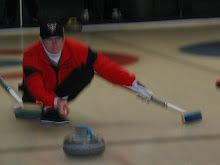 is for Ends, of which there are eight (sometimes - see below). One 'end' of play consists of each team throwing eight rocks to the far set of circles. Rocks are thrown alternately - that is each team takes turns throwing one rock at a time. Once all sixteen rocks have been thrown, the score for that end is counted, the rocks are gathered, and thrown back the other way.
is for Ends, of which there are eight (sometimes - see below). One 'end' of play consists of each team throwing eight rocks to the far set of circles. Rocks are thrown alternately - that is each team takes turns throwing one rock at a time. Once all sixteen rocks have been thrown, the score for that end is counted, the rocks are gathered, and thrown back the other way.
Scoring in curling depends on having rocks closest to the center of the rings. Only one team can score points in one end: the team to whom the rock closest to the center, or button, belongs. The scoring team counts one point for every rock of their own that is closer to the center of the rings than any of their opponent's rocks.
As mentioned above, there are most commonly eight ends in a full game. In some club leagues and bonspiels, games are six ends long, so as to fit more games into a shorter time. At high levels of competition, like the Brier, games are often ten ends long. In most instances, ties after eight (or six, or ten) ends of play are broken by playing an 'extra end.'
Much like Cricket, curling games used to be much longer. It was quite common, at one time, for in-club games to be twelve ends long. The first Toronto Single Rink Championship game, played in 1896, was decided after twenty-two ends of play. That game would have taken five to six hours to complete!
Eight is also the highest number of points a team can score in one end. 'Eight enders' are rare, and for that reason, special note is usually made of them.
<- Start at the beginning.
February 16, 2009
The ABCs of Curling - E
Labels:
ABCs of curling
Subscribe to:
Post Comments (Atom)







1 comments:
A 22 end game? Really? Simply ludicrous. Eight seems much more pragmatic.
Post a Comment